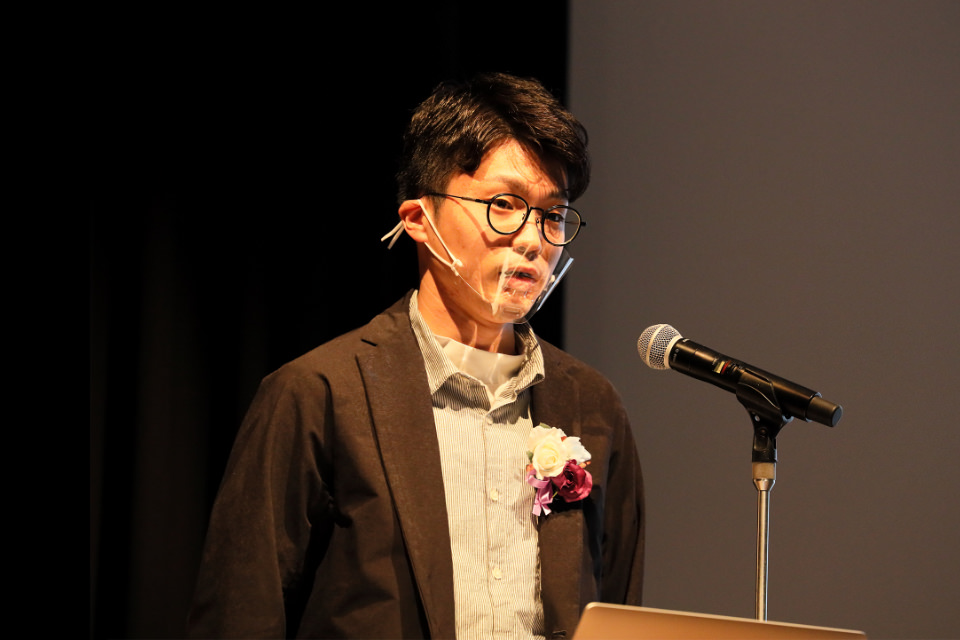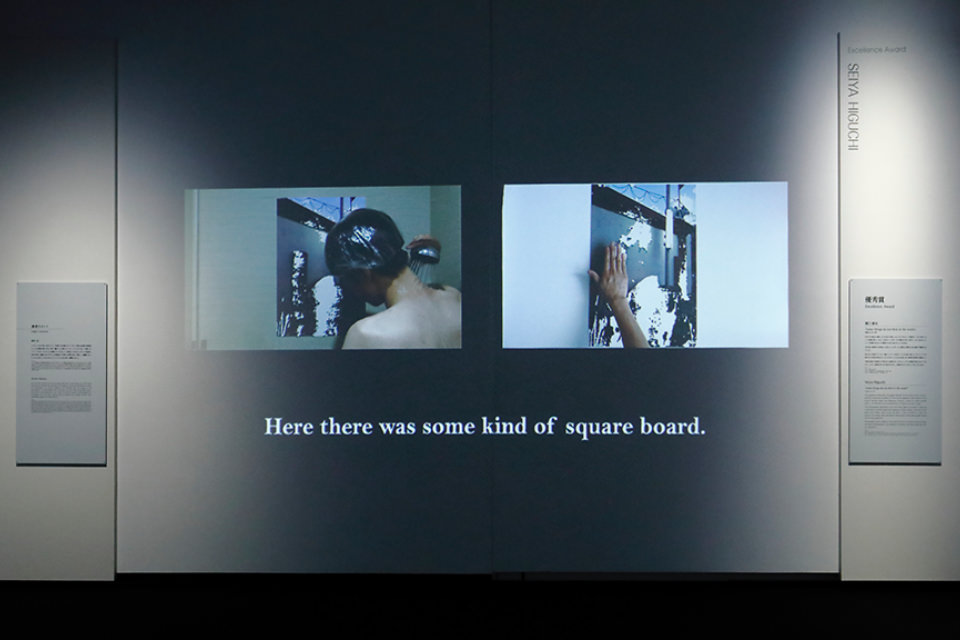PRESENTATION
I created this split-screen video work during a stay in Singapore. The left screen is a video of me taking a shower with photographs I had taken in Singapore. This video depicts how the ink peeled off the photographs as I showered. The right screen is a video of me looking at the photographs and talking while trying to recall what had been in those areas where the ink had peeled off. These two videos placed side by side make up this work.
The work's theme is the relationship between photography and memories. It also poses the question: Which can be evidence of our past — what is captured in photographs or what is remembered by us as memories? In other words, the work considers the relationship between evidence and facts through the lens of the relationship between photography and memories. I had misgivings about the idea that facts disappear in the absence of evidence, or that facts are rewritten when false evidence is presented.
My entry point into this exploration was the history of Singapore and Japan, and I took the saying mizu ni nagasu [literally “let the water carry it away”] as my keyword. Working from these concepts, I attempted to give my work a perspective that encompassed more than a consideration of the photographic medium and make it open-ended.
The saying mizu ni nagasu means to forget past troubles as if they had never happened. It equates to the English expression “forgive and forget”. However, the expression “forgive, but never forget” describes the history between Singapore and Japan. These were the words of Lee Kuan Yew, the founding Prime Minister of Singapore. He apparently said these words when a monument was erected to the victims of Japan's occupation of Singapore during WWII. In Singapore, there are many museums that preserve materials from that time as well as memorial parks and stone monuments, and from these I was able to learn more about the history of both countries. I wondered if I were to replace “forgive, but never forget” with photographs and memories, would I be able to say “I have no photographs, but I have what I remember”.
With this in mind, I washed the ink off printed photographs and later tried to remember what was in the photographs. I was also attempting to see how much I, as a photographer who creates photographic images on a daily basis, actually recalled about my photographs.
I literally had a “naked encounter” with the photographs in the shower room as I washed the ink away. At first glance, this seems comical, but I did this to avoid the political themes in the background of the work coming to the fore and limiting how the work would be perceived. So I purposefully incorporated a performance element in the work of me wearing a shower hat.
My goal with this work was to assert that there are facts we remember even in the absence of evidence. But when I actually tested my hypothesis, I realized this was not always the case and that there were many things I couldn't remember without the photographs. I felt a contradiction: some things do not flow in the water, but other things unfortunately do.
However, I find this contradiction and inconsistency interesting. Despite the emphasis on management and record keeping, and the frequent calls for so-called correctness and consistency, I think there are many contradictions that spill outside of these constraints, and many things that I like and feel attracted to even though I don't understand why. I feel there is a richness to be found in being honest at times about the fluctuations that lie between logic and intuition.


In looking at your work, I felt it contained philosophical questions about memory and images. What was interesting to me was the work's historical background — moreover, a negative history between Singapore and Japan with Japan as the aggressor. Had you studied this history before you went to Singapore? Putting aside whether it appears in the work or not, I think whether you know about this history is important. I heard that you exhibited this work in Singapore. What was the reaction there?
(Higuchi)
I studied the history between Singapore and Japan by going around to reference libraries and other places over about three months before I started working on this project. As for the reaction in Singapore, I'm embarrassed to say that I fell ill just as the exhibition started and returned to Japan without getting any feedback. Later, I did hear from friends who said they had stopped by and watched the exhibit with great interest.

Judges’s Comment
Hiroshi Nomura (selector)
I think your presentation was marvelous. And when I saw your work, I thought it was superb. Your treatment of photographs is totally different from my sense. I do have a several questions for you. First is your reason for creating the work while in Singapore. Did you go to Singapore with a purpose, or did you just go to take pictures? And why the shower hat in your wonderful performance? Why are you washing yourself as well as the photographs? All these questions really drew me into the work. Were the videos scripted? Did you experiment with methods other than those appearing in the work? And finally, what are your plans for the future?
(Higuchi)
I went to Singapore not specifically because of this work but because I had the opportunity to participate in an art camp at the LaSalle College of the Arts for two weeks. Once I was there, I started researching and testing, which led to this work.
There was no script for the videos. I had previously experimented with printing photographs and using water to remove the ink. So all I did was figure out the framing, stuck the photographs on the shower wall, and improvised. When it came to recalling the blank spaces in the photographs, I recorded the video in one take without a script to be completely truthful, even though it is possible to reshoot video. I didn't try out many other versions other than the version you see in the work.
As for my future activities, I'm researching what photographers see in their subjects and their motivation for taking photographs. I hope to continue this research while creating more projects.